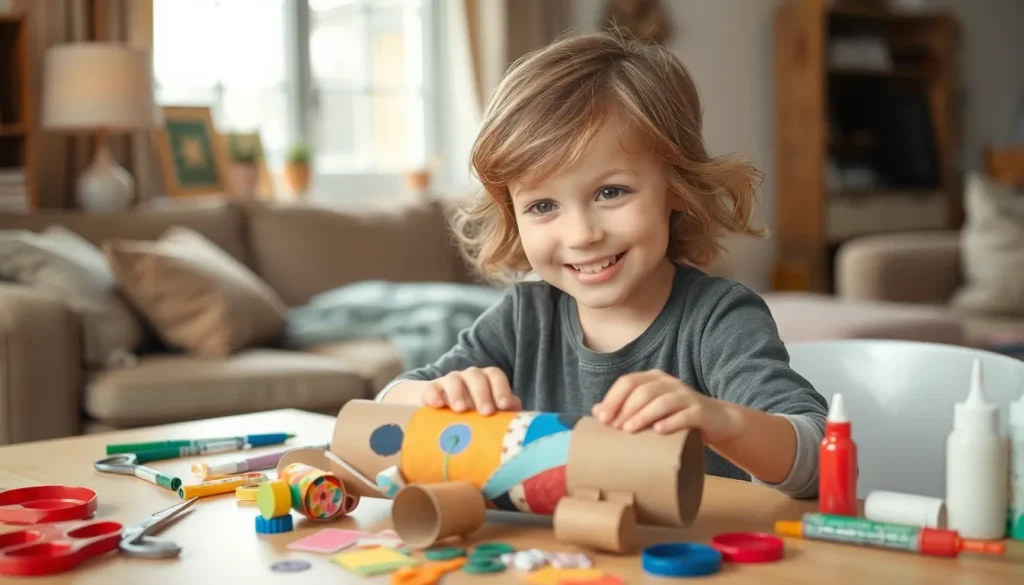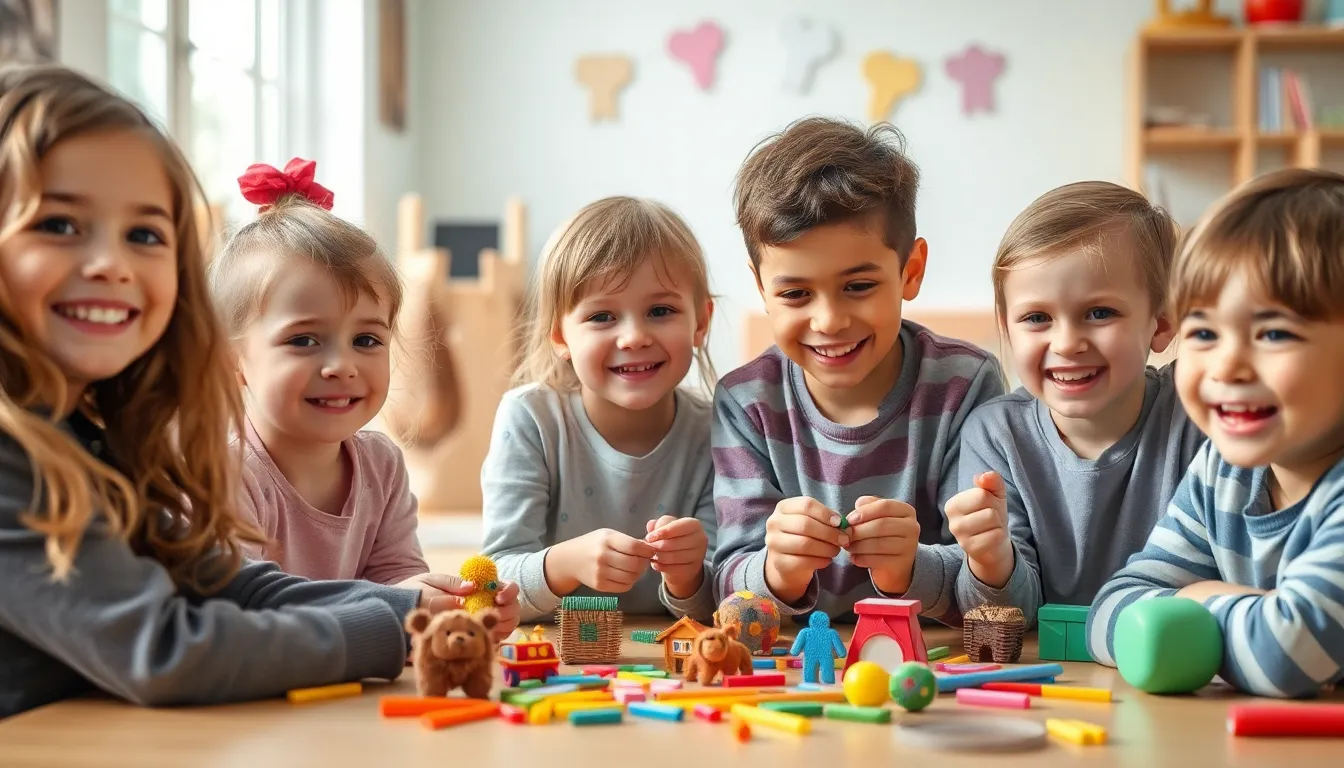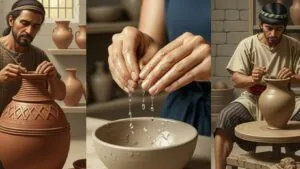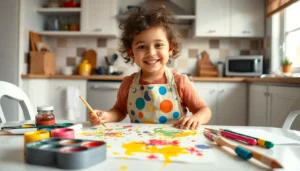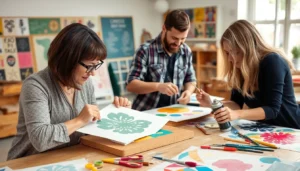Table of Contents
ToggleWhen it comes to keeping kids entertained, store-bought toys can quickly drain the wallet and the imagination. But what if creating playtime magic could be as simple as raiding the recycling bin? DIY toys offer a fun and budget-friendly way to spark creativity in children, turning everyday items into hours of joy.
Overview of DIY Toys for Children
DIY toys encourage creativity and resourcefulness in children. Making toys from household items or recyclables fosters imaginative play and problem-solving skills. Items such as cardboard boxes, plastic bottles, and old clothes can transform into various playthings, presenting countless possibilities.
Many parents value the cost-effectiveness of DIY toys. Creating toys at home often costs significantly less than purchasing new ones. Parents find that they can engage their children in the crafting process while teaching them about sustainability.
Durability often surpasses that of factory-made toys. Children tend to treat DIY toys with care since they invest time and effort in creating them. By involving children in the crafting process, parents instill a sense of ownership and pride.
Safety remains a priority when crafting toys. Choosing age-appropriate materials reduces risks and ensures a safe play environment. Supervision during the creation process enhances safety further, allowing parents to guide their children effectively.
Various resources exist for DIY toy ideas. Websites and social media platforms offer extensive tutorials and inspiration. Access to these resources makes it easier for parents to find projects that suit their children’s interests and skill levels.
Creativity expands when children engage in making their toys. Customization allows them to express their unique personalities and preferences. Through this hands-on experience, children learn critical thinking and develop fine motor skills.
The benefits of DIY toys continue throughout childhood. Creativity cultivated in early years often leads to innovative thinking in later life. Engaging in DIY projects nurtures lifelong skills, providing a rewarding experience for both children and parents.
Benefits of DIY Toys
DIY toys provide numerous advantages for children, enriching their playtime experiences. Cost-effectiveness and imaginative potential stand out as key benefits.
Encouraging Creativity
Make-believe play ignites children’s imaginations. DIY toys invite kids to design their playthings. Utilizing everyday materials helps them express unique ideas. Engaging in crafting offers opportunities for artistic exploration. Children develop their personal style while creating customized toys. Resourceful thinking flourishes when kids repurpose items often disregarded. Through this playful innovation, kids discover new ways to play. Parents can witness their children delight in showcasing personal creations. Each project fosters a sense of pride as children claim ownership of their crafts.
Enhancing Problem-Solving Skills
Constructing DIY toys often presents challenges. Children learn to think critically when facing design limitations. Adjustments are necessary as they navigate trial and error. Experimentation enhances their ability to find effective solutions. If a toy doesn’t work as intended, kids adapt and modify their designs. Persistence builds resilience as they learn from mistakes. Collaborating with friends may lead to shared ideas and pooling resources. Strategy development occurs as children plan their projects. Skills learned during these activities translate well to real-life situations, equipping kids for future challenges.
Popular DIY Toy Ideas
DIY toys come in various forms, enabling endless creativity. Parents can find engaging options that require minimal materials and simple skills.
Craft Projects
Craft projects provide a fantastic opportunity for children to express creativity. Simple items, such as cardboard tubes, paper plates, and buttons, can transform into exciting creations like puppets or robots. Combining these materials fosters imaginative play. Children can decorate their crafts using paints or markers, adding personal flair to their projects. Encouraging kids to share their creations promotes social interaction and collaboration, enhancing their play experience. Various online platforms offer tutorials for easy guidance, making these projects accessible and enjoyable for families.
Building Kits
Building kits, constructed from household items, encourage problem-solving and engineering skills in children. For example, blocks made from recycled cardboard can form structures, while bottle caps can serve as wheels for homemade cars. These kits stimulate creativity and critical thinking as children experiment with different designs. Adding features like ramps or obstacles offers new challenges, enhancing the playtime experience. Collaborating on construction projects fosters teamwork and communication among kids. Simple instructions can help guide the building process, turning ordinary materials into extraordinary toys.
Safety Considerations
Safety is crucial when creating DIY toys for children. Prioritizing materials that are non-toxic ensures a safer play environment. Opt for items like cardboard, fabric scraps, and wood, avoiding small parts that can pose choking hazards. Always check for sharp edges when using tools or cutting materials. Reused items should be free from hazards like toxic adhesives or paint.
Choosing Safe Materials
Selecting appropriate materials prevents accidents. Choose natural or certified non-toxic paints and glues. Cardboard and wood should come from sources without harmful chemicals. Avoid glitter or small beads, as they can be hazardous if ingested. Researching from reliable sources helps identify safe supplies, ensuring a worry-free crafting experience. Scouring local craft stores for eco-friendly options encourages sustainability while providing safe choices for kids.
Supervision and Age Appropriateness
Supervising children during crafting activities is essential. Ages dictate suitable projects, so adapt them to a child’s developmental stage. For younger kids, simpler tasks like decorating larger items keep them engaged without frustration. Older children can tackle more complex projects, promoting independence. Maintaining an open dialogue helps children understand safety regulations while enjoying the crafting process. This guidance fosters responsibility as they learn to handle materials safely.
Resources for DIY Toy Projects
Numerous resources are available to support parents and children in DIY toy projects. Online platforms and community workshops enhance the crafting experience for families.
Online Tutorials
Various websites host comprehensive tutorials for DIY toy projects. Parents can explore platforms like YouTube and Pinterest for step-by-step guides. These tutorials often include video demonstrations, making complex projects accessible for all skill levels. Blogs and forums dedicated to DIY crafts provide inspiration and tips, allowing families to connect with others sharing similar interests. Many resources emphasize the use of recyclable materials, fostering sustainability while engaging children. Accessing these tutorials often sparks creativity, enabling kids to visualize the potential of everyday items.
Community Workshops
Local community centers often offer workshops focused on DIY crafts. Attending these workshops presents opportunities for hands-on learning in a collaborative environment. Families can engage with experienced instructors who guide participants in creating various toy projects. Workshops frequently foster social interactions among children and parents, encouraging teamwork and idea sharing. Many community programs prioritize safety by using non-toxic materials, ensuring a secure crafting experience. Participating in these events can strengthen community bonds while nurturing creativity and resourcefulness in children.
Conclusion
DIY toys offer a unique opportunity for children to explore their creativity while learning valuable skills. By transforming everyday materials into imaginative playthings, kids not only engage in fun activities but also develop problem-solving and critical thinking abilities. The process of crafting these toys fosters a sense of pride and ownership that store-bought options can’t provide.
Parents can feel good about choosing DIY projects as they promote sustainability and affordability. With countless resources available online and in local communities, families can easily find inspiration and guidance for their crafting adventures. Embracing DIY toys enriches playtime and nurtures a child’s development in a safe and enjoyable way.

